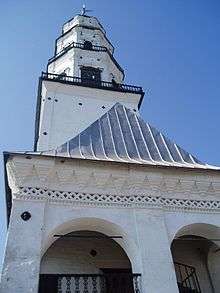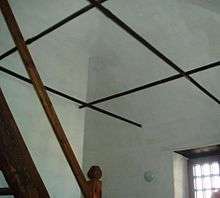Leaning Tower of Nevyansk

The Leaning Tower of Nevyansk (Russian: Невья́нская ба́шня) is a tower in the town of Nevyansk in Sverdlovsk Oblast, Russia, built in the 18th century. Its construction was funded by Peter the Great’s associate and a famous Russian manufacturer Akinfiy Demidov (son of the rich Russian industrialist Nikita Demidov).
The height of the tower is 57.5 meters (189 ft)[1] from the ground and the base is 9.5 meters (31 ft) square. According to recent measurements, the deviation of the top part of the tower from a right angle is currently 2.20 meters (7 ft 3 in). There is still no evidence to this day as to when exactly the Nevyansk Tower was constructed. Russian historians believe that it was built between 1721 and 1745. Also, there is no information about the architect of this unique edifice. The Weather Channel has stated that it was built circa 1732.[1]
The purpose of the tower
Historians are still debating about the exact purpose of the Nevyansk Tower. Some say that Demidov used it as a "bank safe", others believe it was either a watchtower, or a belltower, or a prison,[1] or even a laboratory for conducting chemical experiments and producing counterfeit money. Some historians think that the tower was supposed to embody the might of the Demidov family and serve as some sort of an architectural symbol of their dynasty.

During the restoration works in the tower, archaeologists were able to determine the purpose of some of the rooms. It appears that the first floor of the tower was used for conducting some sort of "secret work" with the help of shackled serfs. According to discovered documents, the second floor may have been Demidov’s "office", where he kept his archives and other papers. The third floor housed a kind of laboratory, equipped with a furnace. A soot sample taken from the flue showed traces of silver and gold in it, but scientists say that the story about Demidov minting coins is probably a myth. Most likely, the tower was used for smelting the top layers of ore-bearing deposits, which often contain silver or gold. Floors four to six have stairwells only. The seventh and the eight floors house a unique clock with bell music made by an English master Richard Phelps in 1730. The story has it that Demidov bought the clock for 5,000 rubles, which was an astronomical amount for that time (for comparison, the construction of the Nevyansk Tower itself cost 4,207 rubles). The clock has three dials, ten music bells weighing about four tons, and one alarm bell. The last ninth floor was probably used as an observation post.
There is one mysterious room in the tower, the purpose of which is still being debated. Archaeologists dubbed it the "acoustic room". It is a 20-square-meter (220 sq ft) room, located between the fourth and the fifth floors. If a person stands in one corner of this room, he or she can whisper words to another person in the opposite corner and they will be perfectly audible. Scientists still do not know whether the room was built like this on purpose or not. It could be that Demidov used this acoustic room for gathering "intelligence" on his high-ranking guests.
The purpose of inclination

One of the legends has it that the inclination of the tower was an idea of some talented architect. They say that the tower was purposely inclined to face southwest in the direction of Demidov’s birthplace[1] in Tula. Supposedly, this is how Akinfiy wanted to demonstrate his affection for his former home. Another legend claims that right after the end of the construction of the edifice Akinfiy Demidov and the architect went on top of the tower. There, Demidov asked him whether he could build anything better than the Nevyansk Tower. The architect answered "yes", and Demidov ordered him thrown down from the top of the building (a rather similar legend is attached to the construction of the Prague Astronomical Clock). The next morning the locals supposedly noticed that the tower had leaned forward a bit and water had started trickling down the walls as if the tower were "crying". Interestingly enough, one can still see some water constantly dripping down the southwest wall of the tower to this day. However, there are a number of natural explanations for this phenomenon.
The restorers say that there is no evidence to even assume that the Nevyansk Tower was purposely built inclined.[1] The current surveying data shows that the defect had to be obvious during the construction. It appears that drifting grounds were to blame for the inclination of the tower from the very beginning. Scientists believe that an uneven subsidence took place when the tower had already been partially built. Most likely, the construction workers stopped building the tower on seeing the defect, but later on they decided to go on with their work. This can be proven by the color of mortar between the bricks, the composition of which changed as the architects worked their way up. It is also visible how the workers started using specially trimmed bricks, with which they tried to even out the tower.[1] It appears that the architects finally succeeded in straightening it out. Current measurements indicate that there is a 3-degree deviation of the base part from the axis, the middle part is already straightened, and the inclination of the tower equals only one degree. The top part of the tower is standing vertically. Local meteorologists say that one can make sure that the top of the tower is absolutely vertical without even using a theodolite by looking at the weather vane on the steeple. It shows the direction of the wind even when the wind is minimal. If the top of the tower were not vertical, the two-meter weather vane weighing 25 kg would always stand still in calm weather in the same position, and this never happens. This explanation ignores the possibility that the weather vane was mounted off-axis from the top of the tower, allowing the weather vane to be straight while the top of the tower is still inclined.
Construction techniques

After having studied the tower, the scientists found out that its architects used some of the most advanced technologies available at that time. The tower's tented roof was the first cast iron cupola in the world, with a metal carcass and metal outer shell. The second time this technique was applied, around 100 years later, was during the reconstruction of the Mainz Cathedral in Germany in 1826, and the third time it was used in the dome of Saint Isaac's Cathedral in St. Petersburg, built in the 1840s. The very top of the tower is crowned with a metallic lightning rod in the shape of a gilded sphere with spikes. These were built somewhere between 1721 and 1745 and have recently been interpreted as lightning rods (existing 28 years before Benjamin Franklin's scientific explanation of such devices). Also, the archaeologists found that in order to fasten the structural parts of the tower, the workers used the principle of reinforced concrete for the first time in the world, or some 130 years before its first recorded use by a Parisian gardener in 1860. The Nevyansk Tower is literally pierced with deeply grounded metal bars (rebars). Another astonishing thing about the tower is that the metal parts used during the construction do not have a slightest trace of corrosion. Scientists say that the iron composition of these parts is 99.6%. Although commonplace today, the process of manufacture of such high-grade material in the 18th century still remains a mystery.
Following the restoration, the Nevyansk Tower was opened to the public. Guided tours are provided by a local museum and tourist guides from Yekaterinburg.
See also
| Wikimedia Commons has media related to Невьянская наклонная б́ашня. |
References
Sources
- Most of the article was translated from the original Russian text in the Itogi Weekly magazine
- Additional material was translated from the Russian text at http://7.ural.ru
- Additional information and photos of Nevyansk tower
Coordinates: 57°29′22″N 60°13′15″E / 57.48944°N 60.22083°E